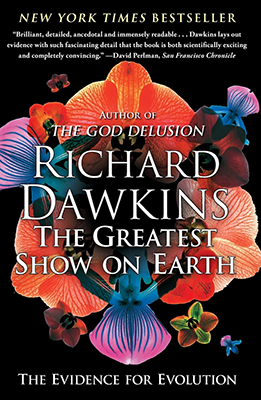The Greatest Show On Earth
“The Greatest Show on Earth: The Evidence for Evolution” by Richard Dawkins is a comprehensive and engaging exploration of the evidence for evolution and the mechanisms by which it operates. Here’s a summary:
Introduction to Evolution: Dawkins begins by introducing the concept of evolution and its central role in modern biology. He discusses the overwhelming evidence for evolution from fields such as paleontology, comparative anatomy, embryology, and molecular biology.
The Fossil Record: Dawkins explores the fossil record and the evidence it provides for the history of life on Earth. He discusses transitional fossils, such as Tiktaalik and Archaeopteryx, which provide crucial evidence for evolutionary transitions between major groups of organisms.
Natural Selection: Dawkins explains the mechanism of natural selection, which acts on variation within populations to produce evolutionary change over time. He discusses examples of natural selection in action, such as the evolution of antibiotic resistance in bacteria and the adaptation of Darwin’s finches in the Galápagos Islands.
Genetics and Evolution: Dawkins explores the role of genetics in understanding evolution. He discusses how genes and mutations provide the raw material for evolutionary change, and he explains how genetic evidence supports the theory of common descent and the relatedness of all living organisms.
Biogeography: Dawkins discusses the patterns of distribution of species around the world and how they provide evidence for evolution. He explores biogeographical patterns such as adaptive radiations, island biogeography, and continental drift, which have shaped the distribution of life on Earth.
Vestigial Structures and Imperfections: Dawkins examines vestigial structures and imperfections in living organisms as evidence for evolution. He discusses examples such as the vestigial wings of flightless birds and the human appendix, which have no function but are remnants of evolutionary history.
Evolutionary Developmental Biology (Evo-Devo): Dawkins explores the field of evolutionary developmental biology, which studies how changes in developmental processes can lead to evolutionary change. He discusses the role of genes such as Hox genes in controlling the development of body plans and the evolution of diverse forms of life.
Creationism and Intelligent Design: Dawkins addresses creationist arguments against evolution and intelligent design. He argues that the evidence for evolution is overwhelming and that creationism and intelligent design are not scientifically valid theories.
Conclusion: Dawkins concludes by emphasizing the importance of understanding and accepting the evidence for evolution. He argues that evolution is not just a theory but a fact, supported by a vast and diverse array of evidence from multiple fields of science.
Overall, “The Greatest Show on Earth” provides a compelling and accessible overview of the evidence for evolution and the mechanisms by which it operates. Dawkins’ clear and engaging writing style makes the book accessible to readers of all backgrounds, making it a valuable resource for anyone interested in understanding the science of evolution.

